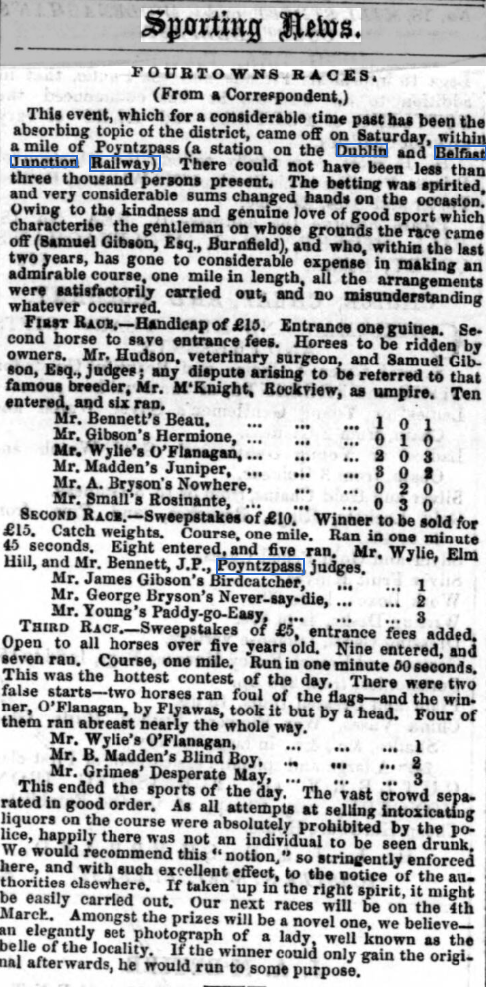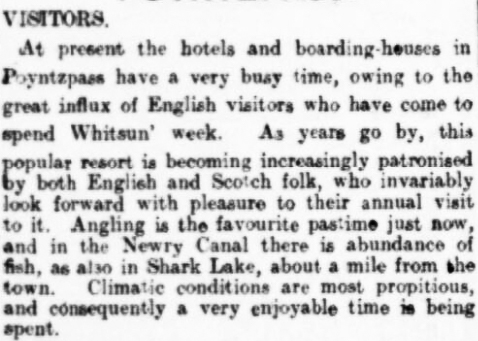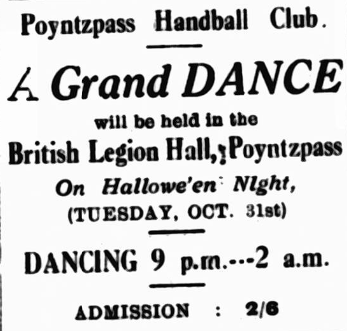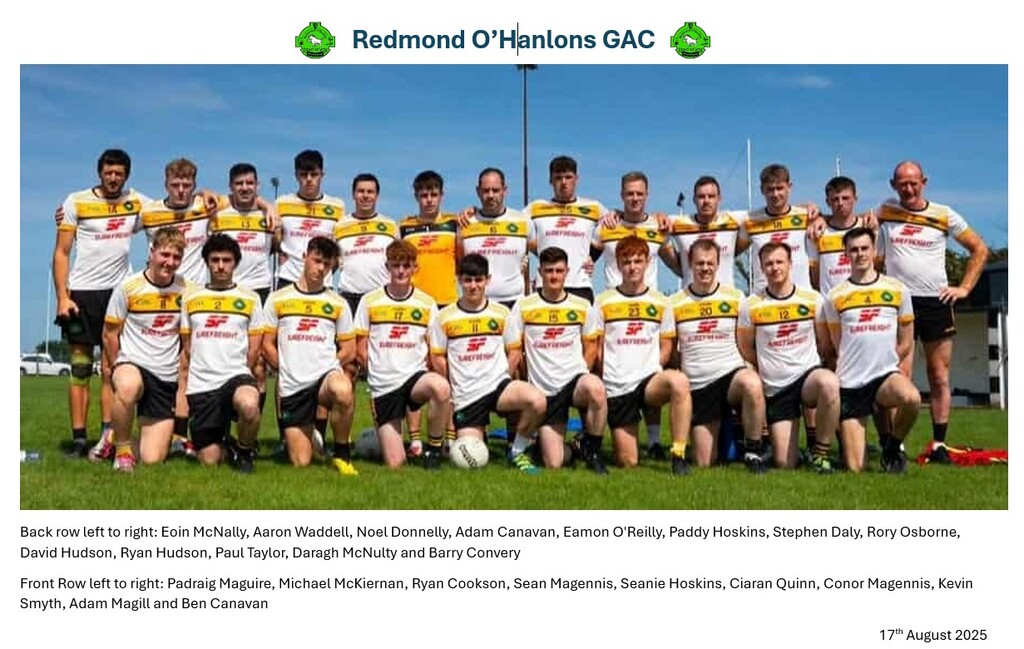Equestrianism

For hundreds of years, the sports of choice for country gentlemen were hunting, shooting and fishing. It was much the same for the lower orders but in their case, it was called poaching, it was often a matter of necessity rather than choice, and it came with severe penalties.
The earliest newspaper report we have of organised local horseracing is from January 1858, when three races were run over a purpose-built one mile course in in Fourtowns, on land owned by one Samuel Gibson. We do not know exactly where this course was.
The newspaper article claims that it was attended by a crowd of 3000, and that this was facilitated by having a railway station at Poyntzpass.
Foxhunting
The Newry Harriers[1] foxhunt was established in 1820, at almost the same time as Col Maxwell Close purchased Drumbanagher and Acton, and the Close family has been closely associated with the Harriers ever since. The Hunt Balls were often held at Drumbanagher Castle. The annual Boxing day meet was usually at Sheepbridge.
The newspapers of the 1800s often carried long detailed reports of their meets, and the precise course the unfortunate fox took before, almost inevitably, it was exhausted, cornered and ripped to shreds.
Point-To-Point
Closely associated with hunting was point-to-point horseracing, over a fixed rural course of fences and hedges. Those who participated were often the same farmers and landowners who rode with the hunt; the difference was the very large number of others who attended simply to watch and possibly to bet on the result.
The Close family initiated the first point-to-point in the area near Mullaglass in 1931, but the course was moved to Taylorstown[2] in 1934.
Mention of point-to-point at Taylorstown in early April 1939 in Belfast News-Letter.
In 1950, the Ulster Transport Authority ran special buses from Belfast and from Poyntzpass railway station.
Shooting
1906, January – Competition held in conjunction with Tandragee Gun Club, of the new-ish sport of clay pigeon shooting. [……..]
In March 1906, the Newry reporter recorded the establishment of Poyntzpass Sporting Club, with Col Close as President. PRONI records mention the existence of a Small-Bore Rifle Club in 1938.
Fishing
Coarse fishing has long been popular in the area, especially when the water level in the Newry canal was still high before regular maintenance stopped in the 1930s. It was a real tourist attraction, and in the early 1900s Poyntzpass hostelries placed adverts in local newspapers in the industrial towns of Lancashire, offering all-in weekly rates for fishing holidays.

Henry Searight of the Cyclists Bar on Church Street offered a week’s board and lodging for 15 shillings in 1907. These holidaymakers probably travelled from Liverpool to Greenore by steamer, and then by train to Poyntzpass. Mick Waddell[6] mentions several more establishments and private homes where the fishing tourists stayed.
In 1904, the Manchester Evening News reported:
“A few members [of the Star Angling Society, Openshaw] recently paid a visit to Poyntz Pass, County Armagh, and met with such good sport that a party is being arranged to pay another visit in August. Bream of upwards of 4 lbs. are quite common, and should by then be in the very best condition…“
Handball
Many generations of Poyntzpass children have played in the handball alley[3], behind the Petty Sessions building, enjoying its strange echoes. It is one of the oldest and largest in Ireland, but practically nothing is known about its origins. No records have come to light of when or why it was built. Some attribute its construction to bored troops stationed at the castle in the 1600s but there is absolutely no evidence to support this. ??? Bennet wrote in his diary:
“…one of the finest in Ireland and some of the best players in the kingdom played there. They used to come from Dublin and elsewhere to play. But the Pass boys could hold their own. It was built by the Stewart family at the foundation of the town.”
This assertion makes sense; the northern end of the village square sits on what would have been the side of a small hill leading down to the stream; a retaining wall on the slope, plus solid infill, would have been needed to allow that side of the square to be built on the level. This is supported by the fact that the back wall of the court has stone block courses up to street level and then brick.
If it was built before Stewart started to develop the village, why was it built in that precise location? Why build a handball alley in isolation? Why build a two-storey high brick wall on top of the stone courses? There would have been much easier and better choices.
If it was built well after Stewart developed the village, the petty sessions building would have been built years before but with only one tiny rear window. This seems inconceivable, and there is no sign in the brick patterns of previous windows having been filled in.
Handball Revival

As long ago as June 1913, Heber Magenis and others were, according to the Newry Reporter, campaigning to have the ball alley refurbished and brought back into use for this “healthy and manly sport”. They must have succeeded because on 31st October 1944, Poyntzpass Handball Club’s annual dance was held in the British Legion Hall. But when was the club formed, and when was it dissolved?
The resurgence of handball across Co Armagh began about 1926. In April, the GAA County Committee reported that there were seven courts available for use in the county. The Frontier Sentinel reported on a later meeting on 2nd July, by which time four teams had entered the county championships (Armagh, Keady, Derrynoose and Poyntzpass), that the Armagh club had built a fine alley, and that “Poyntzpass are determined to make theirs one of the best in Ulster.”
Tennis
Poyntzpass Lawn Tennis Club was formed in 1916.[4] George White, the local stationmaster, was its first Secretary. On 10th May 1935, the Portadown News reported that it had formally opened its new courts.[5] The club’s annual dance was held in late November that same year, and “a sumptuous supper was served at midnight…and dancing continued till 2 a.m.” They knew how to party in Poyntzpass in 1935! However, in 1944, dancing didn’t finish until 3am! There are no newspaper reports that mention the club after 1944.
The 1940 newspaper obituary for John Reside also mentions Drumbanagher Lawn Tennis Club.
Gaelic Football

Soccer
Rugby
[1] See “The Bicentenary of the Newry Hunt” by Edwin Bryson, BIF Vol 16, 2021
[2] See “Taylorstown Point-to-Point” by Edwin Bryson in BIF Vol 15, 2015
[3] See “Poyntzpass Ball Alley” by Dierdre Graham and Frank Watters, BIF Vol 13, 2015
[4] According to Michael Anderson article on George White in BIF Vol 16, 2021, p38
[5] I believe that these were close to the rear of the ball alley. Can anyone confirm? My father, Henry Clarke, regularly umpired matches during the WW2 years. Last mention of the club in the press occurs in 1944. The BIF article on the Bennet family mentions there being tennis courts at the rear of their Railway Street property, and this is probably the same location.
[6] See “Tourists and Evacuees” by Mick Waddell, BIF Vol 1, 1987